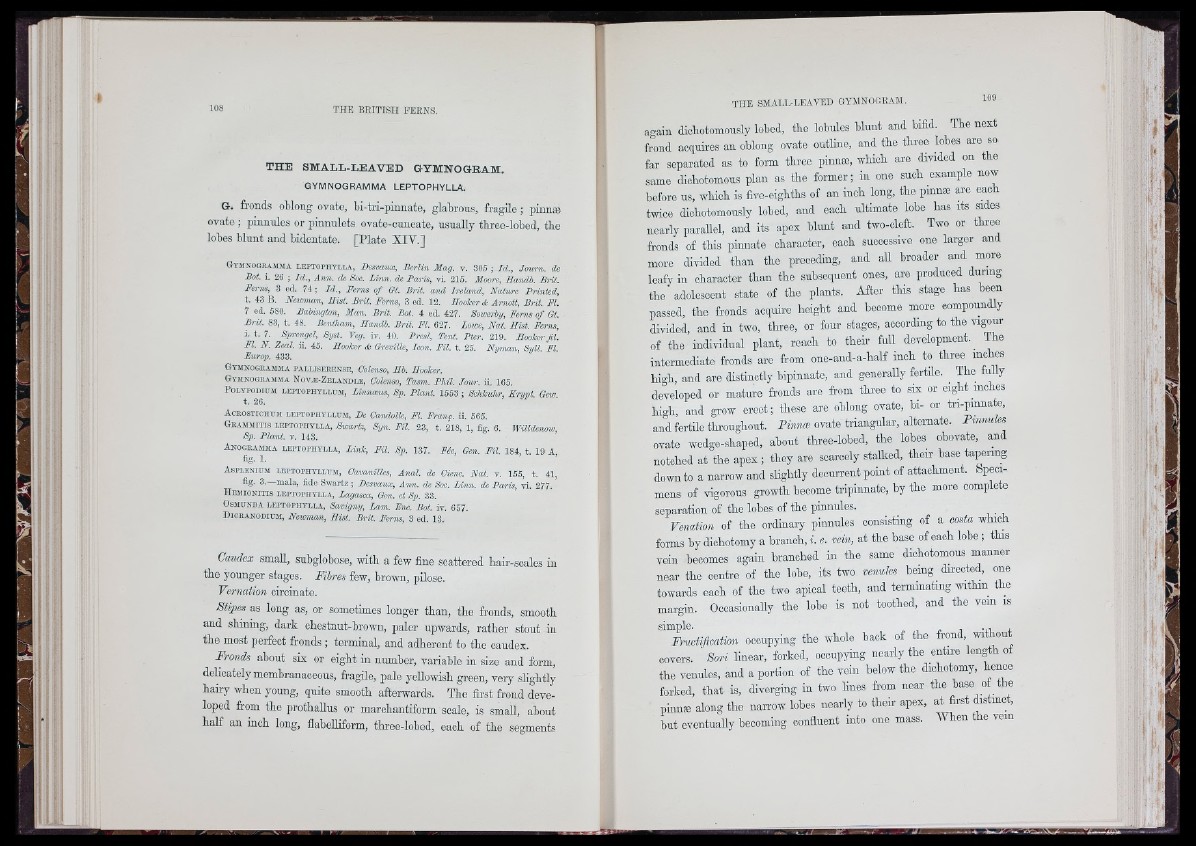
108 THE BRITISH FERNS,
THE SMALL-LEAVED GYMNOGRAM.
GYMNOGRAMMA LEPTOPHYLLA.
G. fronds oblong ovato, bi-tri-pinnate, glabrous, fragile ; pinnæ
ovato ; pinnules or pinnulets ovate-cuneate, usually tbree-lobed, the
lobes blunt and bidentate. [Plate XIV.]
Gymnogramma lE iT o r iiY L L A , Desvaux, Be rlin Mag. v. 305 ; Id ., Journ. de
Bot. i. 28 ; Id ., An n . de Soc. L in n , de Paris, yi. 216. Moore, llandb. Brit.
Perns, 3 ed. 74 ; Id ., Perns o f Gt. Brit, and Ireland, Nature Printed,
t . 43 B. Newman, Hist. B rit. Perns, 3 ed. 12, Hooker A Arnott, Brit. PI.
7 ed. 580. Babington, Man. B rit. Bot. 4 ed. 427. Sowerby, Perns o f Gt.
Brit. 83, t . 48. Bentham, Handb. BHt. PI. 627. Lowe, Nat. Hist. Perns,
i. t . 7. Sprengel, Syst. Teg. i t . 40. Presl, Tent. Pter. 219. Hooker fit.
PI. N . Zeal. ii. 46. Hooker cfc Qreville, Leon. Pit. t . 25. Nyma n , Syll. FI.
Europ. 433.
G ymnogramma pa l l is e r en s e , Golenso, II I . Hooker.
G ym n o g r am m a N o v je -Z e la n d u e , Golenso, Tasm. Ph il. Jour. ii. 165.
P o ly p o d ium l e p t o p h y l lu m , Unnceus, Sp. Plant. 1553 ; Schkuhr, K ryn t Gew
t . 26. > vjr ■
A crostichum l e pto ph y l lum , De Candolle, PI, Prang, ii. 565.
G r am m i ti s LEPTOPHYLLA, Swartz, Syn. Fil. 23, t . 218, 1, fig, 6. Willdenow,
Sp. Plant. V. 143.
A n o g r am m a l e p t o p h y l l a , L in k , Fil. Sp. 137. Pee, Gen. Fil. 184, t . 19 A
fig. 1 .
A spl en ium le pto ph y l lum , Cavanilles, Anal, de Oienc. Nat. y. 155, t . 41,
fig. 3 .—m ala , fide Sw artz ; Desvaux, An n . de Soc. L in n , de Paris, yi. 277.
H em io n it is le pto phy l la , Lagasca, Gen. et Sp. 33.
Osmu nd a l e pto ph y l la , Savigny, Lam. Enc. Bot. iy. 657.
D i c r a n o d iu m , Neumum, Hist. Brit. Ferns, 3 ed. 13.
Caudex smaU, subglobose, with a few fine scattered hair-scales in
the younger stages. Fibres few, brown, pdoso.
Vernation oiroinate.
Stipes as long as, or sometimes longer than, the fronds, smooth
and shining, dark chestnut-brown, paler upwards, rather stout in
the most perfect fronds ; terminal, and adherent to the caudex.
Fronds about six or eight in number, variable in size and form,
delicately membranaceous, fragile, pale yeUowisb green, very slightly
hairy when young, quite smooth afterwards. The first frond developed
from the prothallus or marohantiform scale, is small, about
half an inch long, flabelliform, three-lobed, each of the segments
-iL..
again dichotomously lobod, tbe lobules blunt and bifid. Tbe next
frond acquires an oblong ovato outline, and tho threo lobes are so
far separated as to form three pinnæ, which arc divided on the
same dichotomous plan as the former ; in one such example now
before us, which is fivo-oighths of an inch long, the pinnæ are each
twice dichotomously lohed, and each ultimate lobe has its sides
noarly parallel, and its apex blunt and two-cleft. Two or three
fronds of this pinnate character, each successive one larger and
more divided than the preceding, and all broader and more
leafy in character than the subsequent ones, arc produced during
the adolescent state of the plants. After this stage has been
passed, tho fronds acquire height and become more compoundly
divided, and in two, three, or four stages, according to the vigour
of the individual plant, reach to their M l development.^ The
intermediate fronds are from one-and-a-half inch to three inches
hirii, and are distinctly bipinnate, and generally fertile. Tbe fully
developed or mature fronds are from tbree to six or eight inobes
high, and grow erect ; those are oblong ovate, bi- or tn-pinnate,
and fertile throughout. FmncB ovate triangular, alternate. Pinnules
ovate wedge-shaped, about three-lobed, the lobes obovate, and
notched at the apex ; they are scarcely staUmd, their base tapering
down to a narrow and sUgMly decurrent point of attachment, bpeoi-
mens of vigorous growth become tripinnate, hy the more complete
separation of the lobes of the pinnules.
Venation of the ordinary pinnules consisting of a costa which
forms by dichotomy a branch, i. e. vein, at the base of each lobe ; this
vein becomes again branched in the same dichotomous manner
near tho centre of the lobe, its two venules being directed, one
towards each of the two apical teeth, and terminating within the
margin. Occasionally the lobe is not toothed, and the vein is
simple. « 1 i-
Fructification occupying the whole back of the frond, withou
covers. Sori linear, forked, occupjing nearly the entire length oi
the venules, and a portion of the vein below the dichotomy, hence
forked, that is, diverging in two Hues from noar the base of e
pinnæ along the narrow lobes nearly to their apex, at first distmot,
but eventually becoming confluent into one mass. When the vein
i ii